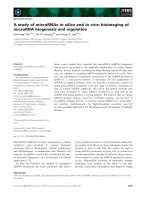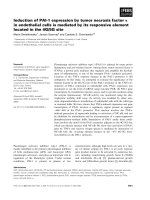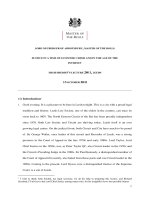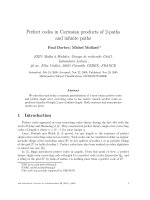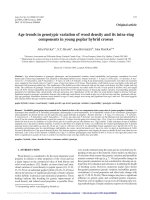Millennium Temple, located in the village of Sai Extract, Grapefruit Guild, Tay Ho district, Hanoi.
Bạn đang xem bản rút gọn của tài liệu. Xem và tải ngay bản đầy đủ của tài liệu tại đây (356.92 KB, 20 trang )
Website: Email : Tel : 0918.775.368
Table of Contents
I/ Introduction…………………………………………………..2
II/ Historical Background………………………………………3
III/ Religious Beliefs and Practices…………………………….4
IV/ Architecture, Statues and Altars……………………………5
1. Architecture………………………………………………..5
2. Statues and Altars………………………………………....9
V/ Heroes, Legends and Festivals………………………………15
VI/ Advice for Visitors………………………………………….16
VII/ List of References……………………………………….....18
I. INTRODUCTION
In recent years, Vietnam has become one of the most famous
destinations in the world. Every year, there are many foreign tourists
traveling to Vietnam. They visit Vietnam for many purposes such as:
business, vacation… but as we see their main purpose is learning about
Vietnam culture or visiting some famous landscapes in Vietnam. And
especially, many of them like visiting pagodas in Vietnam.
1
Website: Email : Tel : 0918.775.368
In Asia countries, pagoda is a very special and sacred place. It makes
people who come to visit pagoda feel very safe, peaceful. And if they can
understand about the pagoda where they visit, it will be more interesting.
That is the reason why we write this report. This is also a good chance for us
to know more about pagoda, about language which is used to talk about
pagoda. It is very useful and good for our job in the future. After finishing
this report, we also know how to organize information in the report, and
especially our English writing skill has improved very much.
So we would like to thank our teachers very much who gave us this
project and helped us this project successfully.
As you know, in Vietnam, here are so many pagodas, people can visit
pagoda in every province with many sizes from small to very large. Some
pagodas are very famous such as: Perfume pagoda, Kim Lien pagoda, Ba Da
pagoda, Tran Quoc pagoda… Numbers of tourist come to see these pagodas
is very high.
But in this project, we would like to introduce to you one pagoda
which is not very famous but it is very beautiful and ancient, it is Thien Nien
pagoda, located in Trich Sai village, Buoi Guild, Tay Ho district, Hanoi.
We choose this pagoda because two main reasons:
- We had some chances to visit Thien Nien pagoda. It is very large,
ancient. It is not so far for us to come.
- We have read some interesting information about this pagoda and it
makes us confident to discover carefully.
Thien Nien pagoda was recognized as a historical and cultural site by state in
31
st
, January, 1992.
2
Website: Email : Tel : 0918.775.368
II. HISTORICAL BACKGROUND
Lying on the bank of Ho Tay and hiding under the shade of ancient
trees, Thien Nien pagoda is a pagoda which was considered to be the most
beautiful and ancient pagoda in the west of Thang Long Citadel.
According to history of this pagoda, in the past, West Lake area is a
stone wood forest. There was a fox with nine tails living in a small mountain
in the forest. It always appeared to disturb domestic animal and people.
King Ly Nam De was very worried about this problem and decided to
send two princesses on learning miracles to kill the fox. On the way to learn
miracles, two princesses met a saint who is named Huyen Thien Hac De (the
King of black cloud and rain). He knew the aims of them and decided to
help them.
After 100 days, two princesses had mastered miracles, they killed the
fox. So that, after they died, King Ly decided to build this pagoda to
dedicate two princesses.
The official name of the pagoda is Thien Nien but local people
nowadays call it Trich Sai pagoda because it is located in Trich Sai village.
Thien Nien pagoda was built under the reign of King Ly Nam De in the sixth
century. Fifteenth centuries has passed, the appearance of the pagoda has
changed a lot after many restoration and repairs. But Thien Nien pagoda as
you see today is the result of a big restoration undertaken in the middle of
the 19
th
century. However, from 15
th
century until now, it was rebuilt many
times especially in 2002 with the surrounding walls and all names of people
who helped to rebuild pagoda were written on the stone stele in pagoda.
3
Website: Email : Tel : 0918.775.368
This pagoda is very large. It covers area of about 10000 m2. It is
surrounding by many big trees and lies on the bank of West Lake. It is very
pleasant for people coming here.
Inside the pagoda, there is a small bell. It was castled in 1862 (under
the reign of King Minh Mang) and 41 statues are kept inside pagoda.
III. RELIGIOUS, BELIEFS AND PRACTICES
As you know, Buddhism had its origins in India, it was founded by a
crow prince Siddhartha.
The main idea of Buddhism is to help people to get away from all
sufferings of the life, to go to Nirvana.
Buddhism was introduced into Vietnam through two ways: from
China and directly from India. Buddhism was accepted by Vietnamese
people after having some changes and popularized by blending with the
traditional beliefs.
Since then, Buddhist pagoda and temple appeared in different times
and different places until every village had its own temple. That is the reason
why nowadays there are many pagodas in Vietnam. By searching these
pagodas, we can not see all the characteristic features of Buddhism, religions
and beliefs in Vietnam. But this will help us understand an important aspect
of the cultural and ideological history of Vietnam.
In Thien Nien pagoda, besides Buddha, people also worship Mother
Saint, Gods and some Monks. Twice per month on the 1
st
and 15
th
of lunar
month, people go to pagoda and temple. They bring offerings such as fruits,
joss-stick… to pagoda and put them on altars. They pray Buddha for their
family, their health, good luck come and avoid bad things.
4
Website: Email : Tel : 0918.775.368
In some occasions, they organize festivals, like Vu Lan festival. In
this festival, they pray for dead soul to be free from sufferings. Besides Vu
Lan festival, Thien Nien pagoda also organize Phat Dan festival (Great
Buddha’s birthday) on the 8
th
of the 4
th
lunar month. In this festival, they use
5 scent water (prepare from different flowers and plants) to pour the
Buddha’s body.
Everyday, as well as in some festivals, all monks in Thien Nien
pagoda say prayers to hope that they will understand Buddha’s theory and be
relaxed. Moreover, they pray to Buddha to bring good health and luck for
everyone.
IV. ARCHITECTURE, STATUES AND ALTARS
1. Architecture
Thien Nien pagoda is arranged in the form of the letter “I” surrounded
by rectangular structure of brick walls. This kind of shape is called “Noi
cong ngoai quoc” which is very popular in the North of Vietnam.
As many Vietnamese pagodas, this pagoda includes 3 parts: three
door gate, courtyard, main hall. The three door gate plays an important part
in each pagoda in Vietnam. This gate is divided into 3 ways of entrance.
Number 3 is odd number. In Vietnamese culture it symbolizes for breed and
happiness. At the roof of three door gate, there are 4 dragons at 4 sides.
According to Vietnamese culture, dragon is one of sacred animals. It
symbols for power of the King and property.
Pagoda is covered with tiles, usually in two layers. The tiles are
shaped like the blade of a big knife. Together, all those tiles look like a lotus.
The symbol of the lotus is widely used in pagoda because of its strong
5
Website: Email : Tel : 0918.775.368
character. Most of the rafters of a pagoda are carved with pictures of dragons
and phoenixes or sometimes flowers.
The main color used in pagoda is brown because it helps create a quiet
and peaceful atmosphere.
The inside pagoda is comprised of three main rooms:
- The 1
st
room of the pagoda is called Bai Duong (place for bow -
towing admiration). In Bai Duong, there are two statues of guardian spirit
(Hộ pháp) or general officials to protect pagoda and Buddha. The two
statues are very big and made of terracotta. The one with the white face is
called Ong Thien (the saint who encourages people to do good and kind
things). The other with the red face and big knife in his hand is called Ong
Ac (the saint who punishes those who do bad and cruel things). A part from
that, there are statues of God and Saint-monk.
- The next room is small room called Ong Muong (Tube room). From
Ong Muong there is a system of statues. Statues of Buddha are placed on
pedestals with the shape of lotus blossoms. The pedestals are carved with
pictures of dragons, waves and flowers that reflect a stable and prosperous
society. This is lead to Thuong Dien (higher temple).
-The last room of the pagoda is Hau Duong (Back room). The room is
used to worship goddesses: Mau Thuong Ngan (Mother goddess of
mountain), Mau Thoai (Mother goddess of water), Mau Thien (Mother
goddess of heaven).
In order to make readers understand more about Thien Nien pagoda,
we use diagrams and picture to explain.
9 9
6
8
Website: Email : Tel : 0918.775.368
7
9 9
5
10
4
3
7
6
Website: Email : Tel : 0918.775.368
1 10
2
Diagram of Thien Nien pagoda
Note
1. The main gate leading to pagoda
2. Three door entrance
3. Courtyard
4. 5. 6. Main Hall
4. Place for bow-towing administration
5. Tube house
6. Back room
7. The house where monks live
8. Area of relic stupas of the patriarchs
9. Garden
10. Brick wall
2. Statues and altars
In the main hall: in this part we would like to describe how people put
statues and altars in the main hall.
8



